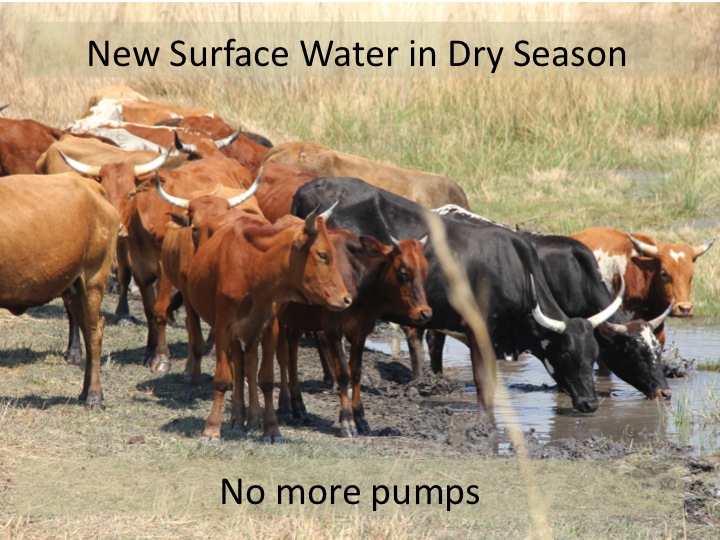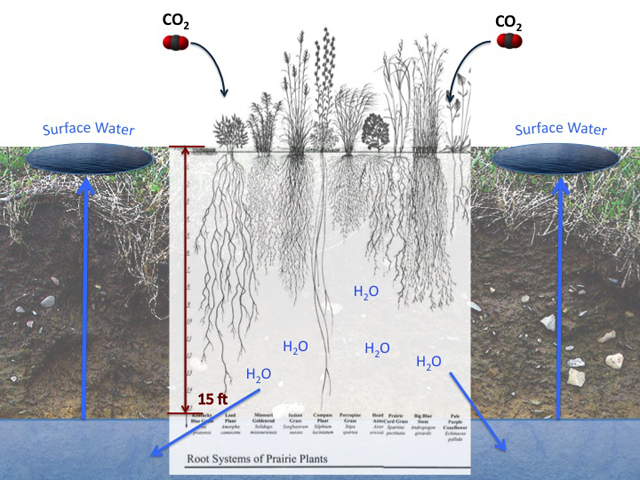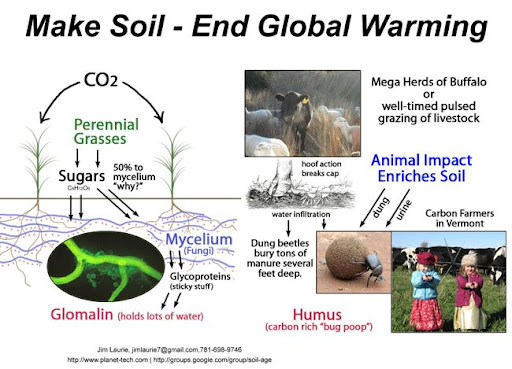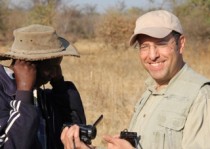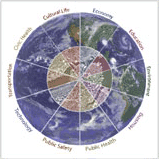You are here
Holistic Management and Water Restoration
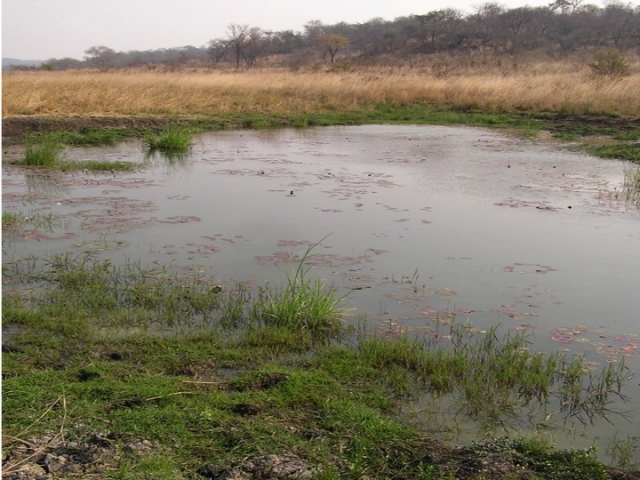
Improving Water Accessibility
Improving water availability is a key reason for doing Holistic Management around the world. This is particularly true in semiarid regions where water access is often scarce. As soils are restored, water tables are replenished, rivers will run longer, and surface pools will stay longer into the dry season.
I discuss this in my TEDx talk in a bit more detail than Savory did in his.
None of the villages that I visited in Africa are doing Holistic Management because of their concern for climate change. They are doing it, in part, because as the land gets better (ie. more grass cover), they not only have more forage for animals, but they also have more plentiful wells and streams. This is a matter of life and death. There are no faucets. Water either comes from a well, or a river, or, unfortunately, an aid organization.
"Enhancing water and food security"
The Africa Center in Holistic Management (ACHM) in Zimbabwe, where I visited in 2011, is being funded, in part, from USAID, specifically to "enhance water and food security and restore degraded watersheds in Southern Africa."
River Restoration
[Restoration on the Dimbanbombe River, Zimbabwe. Year-round surface pools are 1.5 km upstream from their previous high water point in the dry season. After nine years of improving the land, they now have year-round pools, where they never had, and no longer need to run the pumps for the wells. The improved grass cover in the catchment area has helped replenish the water table.]
Below is a video of the training manager discussing that after nine years of improving the land, they now have year-round pools, where they never had, and no longer need to run the pumps for the wells. Thus, they have increased water availability, while eliminating the need for pumps, all while increasing herd size and density, but through an entirely novel approach to livestock management. This is the beauty of this simple and graceful technique that simultaneously addresses desertification, climate change, food production, and drought tolerance.
"The change actually started in 2009. That's when we actually saw some pools in different places. Then (in) 2010, it was flowing almost continuously. And this year, it's expanding sideways."
- Elias Ncube, Training Manager, ACHM
[Elias Ncube, Training Manager at ACHM, discussing the appearance of the new year-round surface pools, now getting wider and deeper. The pumps are no longer needed.]
[Cattle are now watering 1.5 km upstream from the previous dry season high water point. The pumps have been turned off because they are no longer needed. Through proper use of livestock, they have improved the land to the point where there is more water available to supply more livestock, while using less energy for pumps. Photo Credit: Seth Itzkan]
The basic hydrology of this restoration is simple. Any gardener knows that to keep soil moist it must be covered. We do this on our small plots with mulch, and in larger farms with cover crops, or increasingly with non-till farming. The problem is, how do you provide cover over vast areas of non-agricultural rangeland that is undergoing desertification? This is where the innovation of using livestock comes in.
Movable Corrals Maximize Ground Cover - Helps Soils Retain Water
By changing the management of the animals, bare areas of ground can be "targeted" specifically to be covered with dung and plant litter - thus, creating cover. Then, when it rains, the water seeps into the ground, instead of evaporating or running into a gully. One of the ways they create this cover is to have "movable corrals", so that instead of always keeping the animals at night in the same place, they are treated more like a facile herd, which would also, not keep returning to the same place. Over the course of year, many acres of highly denuded land can be "treated" in this way and experience rapid restoration.
Below is a video of ACHM Ranch Manager, Shane Bartlett, discussing this process of moving the corral (called a kraal) every seven to ten days, and, as he says,
"We are trying to cover as many areas as possible throughout the year that are bare patches or eroding, and the kraal is the quick fix. We know that this rainy season that's coming, we'll have good grass where ever we put the kraal."
- Shane Bartlett, Ranch Manager
[Shane Bartlett, Ranch Manager at ACHM, discusses the movable corral (kraal), and the impact that has on forming new grass and improving ground cover.]
Soil Carbon and Water
[Soil carbon and soil water are correlated. As soil organic matter (SOM) increases, so does it's ability to retain water. As more water is retained, water tables are replenished and surface pools retain longer into the dry season. With significant replenishment of water tables, new pools can appear.]
Surface water is an indicator for soil carbon. The more soil organic matter (SOM), the greater the water holding capacity. In soil science this is commonly measured as percent volumetric-water content (%VWC). The paper from Weber (2011) shows that lands under Holistic Management have superior %VWC when compared to other grazing practices, and the paper by Teague (2011) shows that land under similar management has superior SOM. Both are indicators of soil carbon. The climate play in all this has numerous beneficial multipliers. As soil is restored:
• carbon is captured
• water is captured
• habitat for methane metabolizing bacteria is established
• localized cooling is enhanced
• localized warming is diminished
• land is more drought resistant
• localized weather patterns are favorably impacted
Now, multiply this over billions of acres and you start to see the picture.
[Seth Itzkan at new watering hole.]
[Elias Ncube at new watering whole, explaining process]
References
Teague, R. 2011. Grazing management impacts on vegetation, soil biota and soil chemical, physical and hydrological properties in tall grass prairie. Agriculture, Ecosystems and Environment. Volume 141, Issues 3–4, May 2011, Pages 310–322
http://www.sciencedirect.com/science/article/pii/S0167880911000934
- Concludes that multi-paddock grazing (MP) using "adaptive management" is superior to conventional continuous season-long grazing across a range of a ecological parameters, including grass density, soil moisture, soil bulk density, standing crop biomass, and soil organic matter (SOM) - which is a measure of soil carbon.
Weber K.T., Gokhale B.S., 2011. Effect of grazing on soil-water content in semiarid rangelands of southeast Idaho, Journal of Arid Environments, Volume 75, Issue 5, May 2011, Pages 464–470
http://journals2.scholarsportal.info/details.xqy?uri=/01401963/v75i0005/...
- Concludes that "simulated Holistic Planned Grazing (SHPG)" produces superior volumetric-water content (%VWC) when compared with other grazing schemes on similar soil.
- Concluding statement: "While a variety of factors influence soil-water content, holistic planned grazing appears to offer a management alternative with beneficial results measurable on the landscape. In light of these findings, additional studies are warranted relative to the merits of holistic planned grazing and the ability of grazing to favorably modify semiarid landscapes."
- admin's blog
- Log in to post comments

